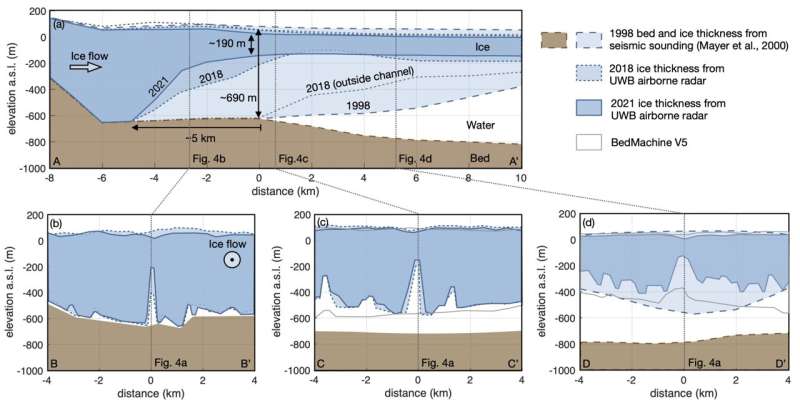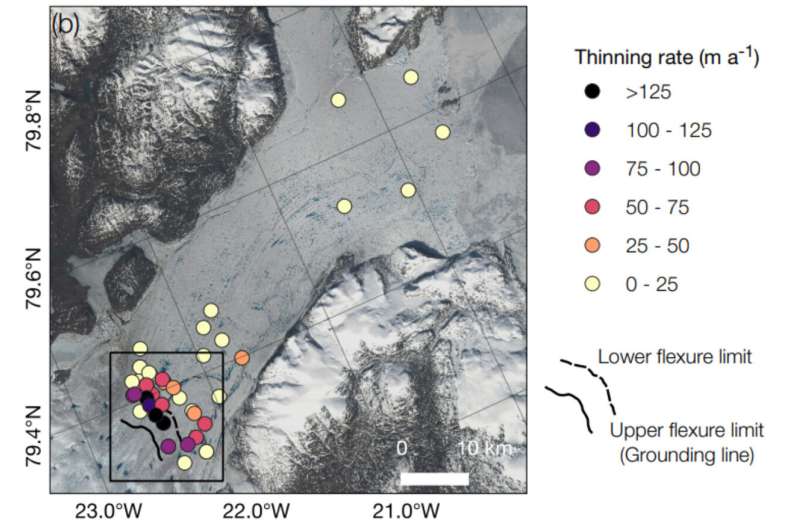August 2, 2023 feature
This article has been reviewed according to Science X's editorial process and policies. Editors have highlighted the following attributes while ensuring the content's credibility:
fact-checked
peer-reviewed publication
trusted source
proofread
Greenland's largest glacial floating ice declined 42% due to global warming, scientists determine

Greenland's ice sheet has been melting at an accelerated rate over recent decades, which may have resulted in a 1.4 mm/year rise in sea level. It has three glaciers with a floating tongue (floating ice attached to a glacier emerging into the sea) remaining, with Nioghalvfjerdsbrae (located at 79 degrees latitude north so colloquially termed 79NG) being the focus of a new study reported in The Cryosphere regarding the effects of climate change on its decline.
Dr. Ole Zeising from Alfred Wegener Institute at the Helmholtz Center for Polar and Marine Research, Germany, and collaborators have used a combination of remote sensing, airborne and ground-level measurements to determine this ice tongue has thinned 42% since 1998, losing an average 38 m ice thickness since 2018. The scientists attribute this to increasing ocean temperatures bringing warmer currents into the area and causing enhanced melting and glacier retreat.
Research since 2010 has used airborne radar to generate images of the surface and internal structure of the glacier, finding that a 500-meter-high and 1-kilometer-wide subglacial (under the glacier) channel has eroded the glacier at the base due to the inflow of warm Atlantic intermediate water (saline water mass originating in the Atlantic that flows at 500 m to 1000 m depth) at temperature exceeding 1°C.
This Atlantic intermediate water brings dense saline water to the base of the glacier, where it flows into the cavity and warms the surrounding ice, causing melting. The more buoyant meltwater then flows further up into the subglacial cavity and intensifies melting of the glacier's base, which has also resulted in distributary subglacial channels forming and spreading out upstream below the glacier which enhances melting further. A water column thickness reaching 140 m has been observed for these two water masses in the cavity.

This subglacial melting has resulted in the overall glacier surface lowering by 7.6 m/year and meltwater flowing at a rapid 150 m/year (predominantly in summer, reducing to almost zero for the remaining months). In one particular location, the glacier surface has lowered ~57 m since 2010. Only 190 m of ice remains overlying this subglacial channel, which is 30% of the surrounding ice thickness, making it susceptible to melting above and below.
Enhanced meltwater rates and volumes are also suggested to arise from increased summer melting of the glacier in line with warmer atmospheric temperatures from global warming. Indeed, the researchers found that the temperature was above 0°C 50% of the time over 70km of the glacier since 2005, increasing summer surface melt. Noticeable cracks have formed at the calving front of the glacier which can be an indicative precursor of disintegration and will exacerbate glacier retreat.
Dr. Zeising notes that previous studies up to 2014 found that the glacier had retreated by 30% since 1999, so conclude that the 42% decline up to the present does not currently suggest an acceleration of melting in recent years. However, this does not mean that continued warming through the century and effects of ice albedo feedbacks won't change this course.
Ice albedo feedbacks work by melting 'white' ice exposing more of the 'dark' land to the incoming solar radiation from the sun. Therefore, more of this radiation is absorbed by the land rather than being reflected back out to space, causing melting of the neighboring snow, which exposes more 'dark' surface and so the loop continues. A good analogy is to think of wearing black clothing in summer, which keeps you warmer compared to white clothing, which helps to reflect heat and maintain cooler temperatures.
Nevertheless, as climate change persists, our ice sheets will continue to melt and polar regions will become ever more susceptible to the effects of warmer oceans, with a host of consequences for the nature that call these environments their home.
More information: Ole Zeising et al, Extreme melting at Greenland's largest floating ice tongue, The Cryosphere (2023). DOI: 10.5194/egusphere-2023-1320
Journal information: The Cryosphere
© 2023 Science X Network




















